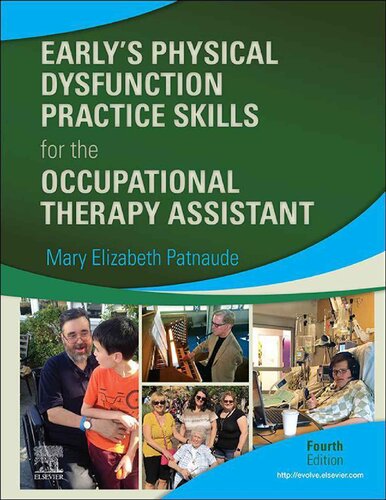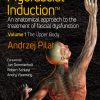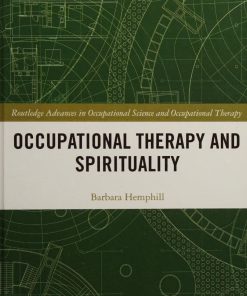Early is Physical Dysfunction Practice Skills for the Occupational Therapy Assistant 4th Edition by Mary Elizabeth Patnaude 0323530842 9780323530842
$50.00 Original price was: $50.00.$25.00Current price is: $25.00.
Early is Physical Dysfunction Practice Skills for the Occupational Therapy Assistant 4th Edition by Mary Elizabeth Patnaude- Ebook PDF Instant Download/Delivery: 0323530842, 9780323530842
Full download Early is Physical Dysfunction Practice Skills for the Occupational Therapy Assistant 4th Edition after payment

Product details:
ISBN 10: 0323530842
ISBN 13: 9780323530842
Author: Mary Elizabeth Patnaude
Master the role and skills of the OTA in caring for adults with physical disabilities! Early’s Physical Dysfunction Practice Skills for the Occupational Therapy Assistant, 4th Edition is the only textbook on the rehabilitation process written specifically for OTA students and practitioners. It takes a client-centered approach, following the latest Occupational Therapy Practice Framework in addressing topics such as assessment, intervention principles, and clinical applications. New to this edition is an Intervention Principles for Feeding and Eating chapter plus the latest advances in OT technology. From a team of expert contributors led by Mary Elizabeth Patnaude, this book shows how you can succeed in the OTA role and help clients learn to perform functional tasks.
- Coverage of advances in OT assessment and intervention includes prosthetics and assistive technologies, along with the assessment and interventions of TBI (traumatic brain injury) problems related to cognitive and visual perception.
- Case studies offer snapshots of real-life situations and solutions, with many cases threaded through an entire chapter.
- Client-centered approach shows how to include the client when making decisions about planning and treatment, using the terminology and abbreviations from the Occupational Therapy Practice Framework.
- Evidence-based content includes clinical trials and outcome studies, especially those relating to intervention.
- Cultural diversity and cultural sensitivity information helps you understand the beliefs and customs of other cultures so you can provide appropriate care.
- Information on prevention addresses safety and the prevention of accidents and injury.
- Key terms, chapter outlines, and chapter objectives introduce the essential information in each chapter.
- Reading guide questions and summaries in each chapter make it easier to measure your comprehension of the material.
- NEW! Intervention Principles for Feeding and Eating chapter is added to this edition.
- NEW! Reorganization of all chapters aligns content more closely with the Occupational Therapy Practice Framework.
- NEW! Combined chapters make the material more concise and easier to navigate.
Early is Physical Dysfunction Practice Skills for the Occupational Therapy Assistant 4th Table of contents:
Part I: Foundations
1. Occupational Therapy Treatment in Rehabilitation, Disability, and Participation
Key Terms
Introduction
Distinct Value of Occupational Therapy in Rehabilitation, Disability, and Participation (RDP) Practice
Physical Dysfunction and Engagement in Occupation
Treatment Continuum in Physical Dysfunction
Theories and Models of Practice in Physical Dysfunction
Evidence-Based Practice
Summary
Review Questions
References
2. Exploring Perspectives on Illness and Disability Throughout the Continuum of Care: A Case-Based Client-Centered Approach
Key Terms
Introduction
Experiencing Disability Throughout the Continuum of Care
Experiences within the Continuum of Care
Communicating with Family and Significant Others
Reflection on the Disability Experience of Lydia and the Components of Mindful and Client-Centered Practice for the Occupational Therapy Practitioner
Summary
References
3. Infection Control and Safety Issues in the Clinic
Key Terms
Introduction
Safety Recommendations for the Clinic
Patient Safety
Infection Control
Incidents and Emergencies
Preventive Positioning for Specific Diagnoses
Precautions with Special Equipment
Summary
Review Questions
References
Resources
First Aid
Hand Washing
Hospital Beds
Infection Control and Universal Precautions
Restraint Use
Part II: Process
4. Occupational Therapy Process: Evaluation and Intervention in Physical Dysfunction
Key Terms
Introduction
Evaluation Procedures
Intervention Planning
Implementation of the Treatment Plan
Discharge Planning and Discontinuation of Treatment
Summary
Review Questions
References
5. Effective Documentation of Occupational Therapy Services
Key Terms
Introduction
Types of Documentation
Standards of Practice for Documentation
Functional Outcomes
Electronic Health Record
Medicare Reports
Summary
Review Questions
References
Recommended Reading
Part III: Assessment
6. Assessment of Motor Control and Functional Movement
Key Terms
Introduction
Motor Control
Dynamic Systems Theory
Neuromusculoskeletal System
Upper Extremity Motor Recovery
Occupational Therapy Intervention Process
Assessment of Upper Limb Function
Summary
Review Questions
References
Recommended Reading
7. Assessment of Joint Range of Motion
Key Terms
Introduction
Role of The Occupational Therapy Assistant in Joint Measurement
General Principles of Assessing Joint Range of Motion
Assessment of Joint Range of Motion
Procedures for Goniometric Measurement and Testing of Selected Upper Extremity Motions
Screening for Functional Range of Motion
Summary
Review Questions
References
Recommended Reading
8. Assessment of Muscle Strength
Key Terms
Introduction
Role of the OTA in Assessing Muscle Strength
The Effects of Muscle Weakness on Occupational Performance
Assessment of Muscle Strength
Manual Muscle Testing
Procedures for Manual Muscle Testing
Functional Muscle Testing
Summary
Review Questions
Exercise
References
Recommended Reading
9. Evaluation and Observation of Deficits in Sensation, Perception, and Cognition
Key Terms
Introduction
Sensation
Perception
Cognition
Insight and Awareness
Summary
Review Questions
References
Recommended Reading
Part IV: Intervention Principles
10. Teaching and Learning: Motor Performance in Occupational Therapy
Key Terms
Introduction
Motor Learning
Distribution and Variability of Skill Practice
Teaching/Learning Process
Methods of Teaching
Summary
Selected Reading Guide Questions
References
11. Mealtime Occupations—Interventions for Feeding and Eating
Key Terms
Introduction
Evaluation of Occupational Performance in ADL, Specifically Mealtime Occupations
Intervention for Mealtime Occupations
Developmental Stages
Phases of Eating/Drinking
Concerns That May Affect Participation in Mealtime Occupations and Intervention Strategies to Address Areas of Concern
Context
Summary
Review Questions
Exercises
References
Recommended Reading
12. Occupations, Purposeful Activities, and Preparatory Activities
Key Terms
Introduction
Occupation
Interplay of the Person, Environment, and Occupation
Methods used in Occupational Therapy Intervention
Summary
Review Questions
References
Part V: Performance in Areas of Occupation
13. Activities of Daily Living
Key Terms
Introduction
Definition of ADL and IADL
Considerations Related to ADL and IADL
Occupational Therapy Process
Evaluation of Occupational Performance in ADL
Community Living Skills
Interventions to Improve Performance in ADL
Adaptive Techniques Utilized for Intervention in ADL
Sexual Activity
Parenting for Individuals with a Disability
Traveling with a Disability
Discharge Planning
Home Assessment
Innovations for ADL and IADL
Summary
Review Questions
Exercises
References
14. Assistive Technology
Key Terms
Introduction
Rehabilitative/Assistive/Universal Technologies
Role of Assistive Technology in Occupational Participation
Types of Electronic Enabling Technologies
Control Technologies
Summary
Review Questions
References
15. Moving in the Environment
Key Terms
Introduction
Section I. Functional Ambulation
Basics of Ambulation
Devices Used During Ambulation
Techniques for Instruction and Safety
The Role of Occupational Therapy in Ambulation Training
Functional Ambulation Application
Summary
Section II. Wheelchair Selection and Evaluation
Therapeutic Goals of the Wheelchair Seating System
Wheelchair Selection Process
Considerations for Wheelchair Selection
Pediatric Wheelchair Considerations
Wheelchair Measurement Procedures
Summary
Section III. Bed Mobility and Transfers
Preparing for the Transfer
Stand Pivot Transfers
Squat Pivot Transfer
One-Person Dependent Transfer
Two-Person Dependent Transfers
Transfer Boards
Mechanical Lifts
Functional Transfers
Summary
Section IV. Importance of Driving and Community Mobility
Purpose of the Driving Evaluation
Candidates for Driving Assessment
Driving Evaluation
Driver Rehabilitation
Driving Cessation
Modes of Community Mobility
Task Demands
Intervention
Pedestrian Safety
Summary
References
16. Work
Key Terms
Introduction
History of Occupational Therapy Involvement in Work Programs
Occupational Rehabilitation
Ergonomics
Job Demand Analysis
Worksite Evaluation
Work Hardening and Work Conditioning
Transition Services from School to Work
Summary
Review Questions
References
17. Promoting Engagement in Leisure and Social Participation
Key Terms
Leisure and Social Participation
Importance of Leisure and Social Activities in Everyday Life
Importance for People with Disabilities
Facilitating Leisure and Social Participation
Summary
Selected Reading Guide Questions
Learning Activities
References
Resources
Part VI: Interventions for Performance Skills and Client Factors
18. The Older Adult
Key Terms
Introduction
The Stages of Aging
Theoretical Approaches to Aging
Age-Related Changes
Physiologic Conditions Complicated by the Aging Process
Cognitive Changes
Practice Settings
Interventions to Promote Quality of Life for Older Adults
Summary
Selected Reading Guide Questions
References
19. Principles of Orthotic Fabrication
Key Terms
Introduction
Structures of the Hand
Hand Function
Principles of Orthotic Fabrication
Orthotic Fabrication
Summary
Review Questions
References
Recommended Reading
20. Neurotherapeutic Approaches to Treatment
Key Terms
Introduction
Rood Approach
Movement Therapy: Brunnstrom Approach to Treatment of Hemiplegia
Proprioceptive Neuromuscular Facilitation
Neurodevelopmental Treatment of Adult Hemiplegia: Bobath Approach
Summary
Review Questions
References
21. Interventions for Visual and Other Sensory Dysfunction
Key Terms
Introduction
The Sensory System
Interventions for Sensory Dysfunction
Summary of Interventions for Sensory Dysfunction
Interventions for Vision Deficits and Visual-Perceptual Dysfunction
Vestibular Function
Summary
Review Questions
References
22. Intervention for People with Cognitive and Perceptual Deficits
Key Terms
Introduction
Occupational Therapy Intervention Process
Principles of Cognitive Retraining to Enhance Learning and Memory
Summary of Intervention for Those with Cognitive Impairments
Intervention for Perceptual Deficits
Summary of Interventions for Cognitive and Perceptual Deficits
Summary
Review Questions
References
Part VII: Clinical Applications
23. Cerebrovascular Accident
Key Terms
Introduction
Medical Management
Domains of Occupational Therapy Intervention
Areas of Occupation and Occupational Therapy Treatment Techniques
Summary
Review Questions
References
Recommended Reading
Online Resources for Stroke Survivors and Caregivers
24. Traumatic Brain Injury
Key Terms
Introduction
Changes in Body Structures and Functions
Classification of Injury
Occupational Therapy Evaluation
Occupational Therapy Intervention for Clients at a Low Functional Level
Summary
Review Questions
References
25. Degenerative Diseases of the Central Nervous System
Key Terms
Introduction
Conditions
Summary
Review Questions
References
26. Spinal Cord Injury
Key Terms
Introduction
Spinal Cord Injury Presentation and Implications
Medical and Surgical Management of Spinal Cord Injury
Occupational Therapy Process
Summary
Review Questions
References
Suggested Reading
27. Neurogenic and Myopathic Dysfunction
Key Terms
Introduction
Neurogenic Disorders
Diseases of the Neuromuscular Junction
Myopathic Disorders
Summary
Review Questions
References
28. Arthritis and Lower Extremity Joint Replacement
Key Terms
Arthritis
Interventions for Arthritis
Occupational Therapy
Occupational Therapy Treatment Process
Summary
Review Questions
References
29. Upper Extremity Rehabilitation
Key Terms
Introduction
Occupational Therapy Intervention Process
Intervention Techniques
Summary
Review Questions
References
30. Burns
Key Terms
Introduction
Skin
Objective Measures of Burn Injury Severity
Medical Management of Acute Burn Injuries
Occupational Therapy Process in Burn Rehabilitation
Assessment of Occupational Performance
Summary
Review Questions
References
Resources for Custom-Made Garments
Resources for Overlay and Insert Materials
Internet Websites and Blogs
31. Amputation and Prosthetics
Key Terms
Introduction
Upper Limb Amputations
Upper Limb Amputations
Preprosthetic Training
Prosthetic Training
Preparing for the Prosthesis
Lower Limb Amputations
Summary
Review Questions
References
Recommended Reading
Resources
32. Cardiac Dysfunction and Chronic Obstructive Pulmonary Disease
Key Terms
Introduction
Cardiovascular System
Pathology of Cardiac Disease
Anatomy and Physiology of Respiration
Chronic Obstructive Pulmonary Disease
Pulmonary Rehabilitation
Evaluation and Treatment of Persons with Cardiopulmonary Dysfunction
Summary
Review Questions
Exercises
References
33. Oncology
Key Terms
Introduction
Personal Meaning and a Diagnosis of Cancer
Issues Concerning Death and Dying
Summary
References
Recommended Reading
34. HIV Infection and AIDS
Key Terms
Introduction
Assessment of Occupational Performance
People also search for Early is Physical Dysfunction Practice Skills for the Occupational Therapy Assistant 4th:
3 physical disabilities
3 types of physical disabilities
what are the 4 principles of physical activity
physically difficult activities
Tags:
Mary Elizabeth Patnaude,Physical,Dysfunction,Practice
You may also like…
Medicine - Health-Related Professions
Medicine - Therapy
Medicine - Therapy
Medicine - Health-Related Professions
Politics & Philosophy - Social Sciences
Social Work Skills for Beginning Direct Practice 4th Edition Linda K. Cummins
Medicine - Therapy
Medicine - Therapy











